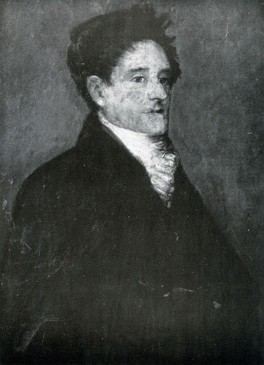- Cronología
- 1824
- Ubicación
- Private collection
- Dimensiones
- 73 x 59 cm
- Técnica y soporte
- Óleo sobre lienzo a partir de una base al temple
- Reconocimiento de la autoría de Goya
- Documented work
- Titular
- Private collection
- Ficha: realización/revisión
- 31 Dec 1969 / 16 Jun 2023
- Inventario
- -
Goya (lower left-hand corner).
Paris 1824 (lower right-hand corner).
When Goya obtained the king's permission to leave Madrid with the excuse of "taking the waters at Plombières to relieve the illnesses and ailments" of his old age, he headed to Paris, where he stayed for two months. There he met Joaquín María Ferrer and his wife, whom he also painted.
The pair of portraits belonged to the collection of the Count of Caudilla, in Madrid, who was their owner when they were exhibited in 1900. At the time of the Bordeaux show of 1951 they were in the collection of the Marquis of Baroja, also in Madrid. They later entered the collection of the Marchioness of Gándara, in Rome, until arriving at the private collection where they are today.
Joaquín María Ferrer y Cafranga (Pasajes de San Pedro, Guipúzcoa, 1777-Santa Águeda, 1861) was a politician. He was elected member of parliament in 1822, Finance Minister in 1836, Minister of State in 1840 and President of the Council of Ministers in 1841. During the reign of Ferdinand VII he was forced to leave the country with his wife, since he had become to be considered a dangerous revolutionary. He settled in Paris. Goya was also put under police surveillance due to his relationship with Ferrer, which was confirmed by this portrait and the letters that he wrote to him.
The half-length portrait shows Ferrer in a black jacket with white tie. He is holding a small book in his hands, alluding to his work as a publisher. He was responsible for a miniature edition of El Quijote. His hair is curly, his features sharp and angular, and upon his face is a worried look. The rapid execution of the portrait and the clear marks left by the brush bring this work close to expressionism, an impression that is further favoured by the sitter's hard-edged features.
-
Goya 1900Ministerio de Instrucción Pública and Bellas ArtesMadrid1900consultant editors Aureliano de Beruete, Alejandro Ferrant, Marqués de Pidal and Ricardo Velázquez. May 1900cat. 113
-
GoyaMinistry of Foreing AffairsBurdeos1951organized by the Bordeaux City Hall, consultant editor Gilberte Martin-Méry. From May 16th to June 30th 1951cat. 57
-
Goya: Prophet der ModerneAlte NationalgalerieBerlin2005from July 13th to October 3th 2005. Exhibitied also at the Kunsthistorischemuseum, Vienna, October 18th 2005 to January 8th 2006, consultant editor Manuela B. Mena Marquéscat. 139
-
Goya’s last WorksThe Frick Art CollectionNew York2006consultant editors Jonathan Brown and Susan Grace Galassi. From February 22nd to May 14th 2006cat. 8
-
Goya: The PortraitsLondon2015cat. 66
-
Bilbao2018cat. 10
-
GoyaBasle2021p. 352
-
L'œuvre peint de Goya. 4 volsParís1928-1950vol. II, p. 227, cat. 516
-
Manojo de noticias. La suerte de Goya en FranciaBulletin Hispanique, Annales de la Faculté des Lettres de Bordeaux1950pp. 238-240
-
Vie et ouvre de Francisco de GoyaParísOffice du livre1970pp. 356, 361, cat. 1659
-
BarcelonaPolígrafa1970vol. I, p. 385, cat. 735
-
L’opera pittorica completa di GoyaMilanRizzoli1974p. 135, cat. 656
-
Goya’s last worksNew YorkThe Frick Collection and Yale University Press2006p. 100, cat. 8 y p. 102 (il.)
-
Francisco de Goya, 4 vols.ZaragozaCaja de Ahorros de Zaragoza, Aragón y Rioja1980-1982vol. IV, p. 194 y p. 325 (il.)
-
LondonNational Gallery Company2015pp. 198-200
